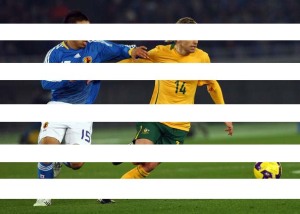You must have seen these numbers referring to quality of laptop screens, TVs or monitors. You might argue associating these numbers with video quality as well. Oh, wait did you also see these numbers written on a digital camera? The numbers are indeed confusing. So an easy to read yet technical description on these numbers – just read ahead!
The letters suffixing the these numbers. The i in ‘1080i’ stands for ‘Interlaced’. Have a look at the pictures below:
The 2 parts of the same picture:
A word of caution before we proceed – I’ll be talking in terms of ‘Video Quality’ first. There is the original picture – P1. Pictures P2 and P3 are say the blocks of a puzzle which combines to form p1. If the pictures P2 and P3 are flipped at a very high frequency, the human eye cannot distinguish if these where two different pictures at all and what you see is a single picture as in picture 1. But a video is not a single image. Right, a video is a collection of pictures flipping at a very high rate.When you pause a video you get some still image on your screen. The image that was being projected was a combination of two pictures as I showed above. So at any point in the video, only half the picture is being projected, which is obviously being flipped so fast that you can’t make out. To get a bleak idea on how it may feel – save these pictures in a new folder and then change them using the arrow keys in Windows Picture Viewer.
You can also compare interlaced projection to painting a picture – with odd lines painted first followed by the even lines.
Now for the letter ‘p’. ‘p’ stands for ‘Progressive’. As the names suggests pictures are progressively flipped in such type of a video. Unlike an interlaced projection where virtually only half of the image is screened at any point of time in progressive projection complete pictures are screened.
So you may think, obviously the progressive is a better quality any day. A full picture being flipped is obviously better than a half. I recommend you to read ahead before you make a decision.
Now for the numbers. We can’t leave the numbers behind in our discussion of progressive and interlaced projections. 1080 corresponds to the resolution of 1,920×1,080 pixels or 1080 lines of vertical resolution. 720p stands for 1280 x 720 pixels or 720 pixels of vertical resolution. So 1080i would mean a resolution of 1920×1080 pixels being projected in a interlaced manner and 1080p would mean the same resolution being progressively projected. Now we can safely say that 1080p is a better quality projection than 1080i. But there is ambiguity over the 720p projection. Some say that the 1080i quality is better than the 720p while others believe that progressive projection improves video quality and hence 720p is better than 1080i. However 1080i is definitely better than 420p. Even though 420p is progressively projected – the resolution is very low with just 640×480 pixels.
Talking in terms of the displays – the TV’s, the computer monitors and in terms of the pictures that are clicked by modern day digital cameras. As I mentioned 1080 is equivalent to 1920x 1080 pixels, but your screen should support that resolution to display such high quality. So if your screen supports that kind of resolution you’ll find it labelled HD Display or HDTV for a TV. (There are other factors determining if a display is HD or not – but we leave that discussion of frequencies and bandwidths for this post). Even if your display is not HD capable it does plays the HD videos or display HD Pictures. That’s where referring the quality in terms of lines of resolution comes into play. Your picture or video may have a resolution of 1080/720/480 vertical lines with no consideration of the display it will be projected on. The quality of the output is retained irrespective of the display. You’ll feel the difference between the quality of the videos of different on most screens (barring the CRT displays – again a long explanation on why).
You might like calling these numbers with some special names:
High Definition or HD for 1080p.
Standard Definition for 720p. Also called HD in 720p.
Enhanced Definition for 480p.
My take on content quality is 1080p>720p ≈1080i>480p. I hope you find this information helpful for your next ‘Gadget Shopping’!


